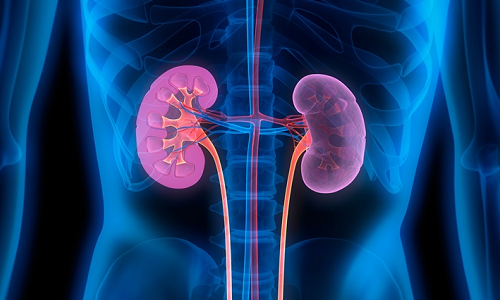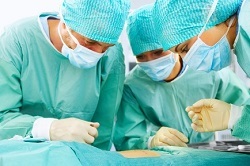A number of diseases that can affect any person are often hidden, and as a result they are difficult to treat. One of those is considered to be kidney hydrocalysis - a condition of pathological development that inevitably results in partial or complete expansion and extension of the cup, pelvis of the kidney followed by damage to its tissues. The causes of this condition are mainly due to renal failure, infectious and inflammatory diseases of the body, pinching of the renal papilla.

Why does hydrocalysis develop?
All diseases develop for any reason that has an indirect or direct effect. Given the nature of the kidney hydrocalicosis, it becomes clear that the pathology is associated with a violation of the outflow of urine due to the overlap of the path from the kidneys to the bladder. In practice, there is often a right-sided hydrocalicosis, but this does not exclude left-sided or bilateral development of the disease.
If unilateral kidney hydrocalicosis can be easily treated with timely diagnosis, then with a bilateral hydrocalysis, the healing process requires a long time, based on a complex treatment regimen. Speaking of the reasons, it is understood that they can be:
- renal( immediate);
- extrenaline( mediated).
Renal factors of hydrocalysis are caused by the following abnormalities or diseases:
- tuberculosis;
- by nephrolithiasis;
- with a tumor of kidney tissue;
- with nephroptosis;
- congenital or acquired defect of the renal calyx, resulting in its squeezing;
- the presence of sand or small pebbles in the kidneys, ureters;
- omission of the organ, which subsequently leads to an inflection of the renal peduncle;
- injuries, inflammation in the organs themselves.
Extrarenal factors are characterized by:
- development of a tumor of the abdominal cavity;
- congenital pathology of the development of the vascular system;
- with a lymphatic vessel defect;
- significant damage to the urinary organs due to enlarged lymph nodes that squeeze them;
- pathological lesions located around the organs;
- congenital malformation of the entire genitourinary system.
Patient should be aware that any factor of renal hydrocalysis is an autonomous disease requiring special attention and appropriate treatment.
Symptomatic of hydrocalicosis
The kidney hydrocalcalosis can often be of a hidden nature, in no way manifest, which complicates the process of its detection. With such a course of the disease, the patient does not consult a doctor for timely treatment, due to which the process of damage is aggravated. Sometimes the symptoms of hydrocalysis are similar to those of other diseases, which is the reason for the wrong treatment. Therefore, the most important is the examination of the patient with the establishment of an accurate diagnosis.
 With hydrocalysis, a patient may be disturbed by a sudden severe chills, accompanied by fever, which can reach 39-40 degrees. Usually the temperature drops only after the process of urine outflow normalizes. Another symptom is characterized by the appearance of sharp pain in the spinal cord. The pain may be single or persist for a while. Sometimes pain can affect the lumbar region, but can spread to the lateral or inguinal areas.
With hydrocalysis, a patient may be disturbed by a sudden severe chills, accompanied by fever, which can reach 39-40 degrees. Usually the temperature drops only after the process of urine outflow normalizes. Another symptom is characterized by the appearance of sharp pain in the spinal cord. The pain may be single or persist for a while. Sometimes pain can affect the lumbar region, but can spread to the lateral or inguinal areas.
Pain of the lumbar region is accompanied by increased soreness when trying to move or careless touch, which causes nausea, loss of appetite, a feeling of weakness and even vomiting. After vomiting, the patient does not feel relief, since the main factor that provoked the development of these symptoms is still there.
In addition to the features discussed, kidney hydrocalicosis is accompanied by frequent urges to urinate. Each of the processes of urination is characterized by the release of a small amount of urine, which can have a murky color due to the presence of blood in it, as well as an unpleasant smell.
Since the above symptoms of hydrocalicosis may occur in other diseases characteristic of the gastrointestinal tract, the diagnosis should be made by an experienced urologist, guided by the results of the examination or analysis. Diagnostic measures for hydrocalysis are thorough in nature,accurate diagnosis. Speaking of diagnosis, it is understood that the patient must undergo all stages of the examination, including instrumental, laboratory. The diagnosis is based on:
- review radiography of the abdominal cavity;
- excretory urography with mandatory application of contrast agents;
- renal urography;
- retrograde ureteropyelography;
- computed tomography;
- magnetic resonance imaging;
- multispiral tomography;
- clinical as well as biochemical laboratory studies.
Treatment methods for elimination of renal hydrocalysis
Kidney hydrocalysis can be successfully treated only after determining the factor that caused the development of the disease. It is from the revealed cause, as well as from the clinical picture of the manifestation and condition of the patient, that the choice of the most optimal treatment depends, which can be:
- medicamental;
- surgical.
Drug therapy for organ hydrocalysis is appropriate only when the cause of the disease is infection or bacteria that prevent a normal outflow of urine. Often, drug therapy is used in cases where stagnation of urine promotes the formation of various bacteria in the kidneys. The selection of the most effective antibacterial drugs is carried out, to which the detected bacteria show sensitivity.
This is the first stage of treatment. The second stage is operational, aimed at removing obstacles. Speaking of surgical intervention, it means two of its types: cavitary( classical) or endoscopic intervention. The choice of one of them depends on the condition of the damaged organs, the results of the examination. However, the most sparing, more effective is the endoscopic method of intervention.
 The procedure for endoscopy is that during the operation 3 punctures of the abdominal wall are performed, through which the process of eliminating the defect is carried out. The operation is controlled by a surgeon using a monitor on which all actions are depicted. The duration of the operation is no more than 1 hour. Practice shows that endoscopic treatment of hydrocalicosis reduces the risk of possible complications, so this method of treatment is often used.
The procedure for endoscopy is that during the operation 3 punctures of the abdominal wall are performed, through which the process of eliminating the defect is carried out. The operation is controlled by a surgeon using a monitor on which all actions are depicted. The duration of the operation is no more than 1 hour. Practice shows that endoscopic treatment of hydrocalicosis reduces the risk of possible complications, so this method of treatment is often used.
The rehabilitation process is short-lived, but after the final recovery the patient should undergo an ultrasound examination every 3 months, and every year a complete examination with the attending physician to prevent repeated kidney hydrocalysis or to detect it in time, taking the necessary measures.
Znahar recipes as prophylaxis of kidney hydrocalysis
It is often recommended to follow the prescriptions of traditional medicine, including various decoctions, herbal infusions, which possess bactericidal, anti-inflammatory properties, in the preventive purposes of preventing any disease. To prevent the development of hydrocalicosis, enjoy decoctions of juniper.
In parallel, it is recommended to reduce the consumption of protein foods, high-calorie, fatty foods. Beneficial to the work of organs affect berries( currants, raspberries, as well as cooked from them compotes, fruit drinks), some dairy products( skim curd, kefir, low-fat sour cream).
Observance of elementary rules of personal hygiene has always been considered as a factor of a healthy body. Therefore, patients who have already faced with kidney problems should strictly treat personal hygiene, observing all the rules. Prevention of hydrocalicosis also has an increased consumption of liquid, including light soups, home-made compotes, ordinary drinking water, fruit, vegetable, berry juices.
Important to know: kidney hydrocalysis is a serious disease. Absence of treatment or late visit to the doctor can lead subsequently to the loss of one kidney.



